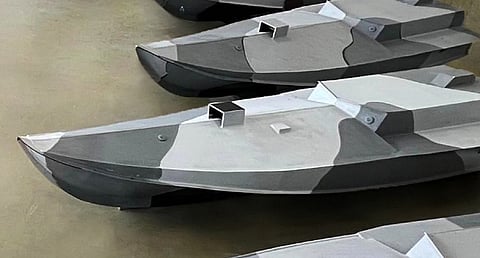

Offshore aspects of the Russia-Ukraine conflict have brought into sharp focus the rising profile of asymmetrical naval warfare, with uncrewed surface vehicles (USV) assuming a dominant role.
Russia has deployed warships of its Black Sea Fleet in support of a three-pronged maritime strategy, focused on offshore blockade enforcement, the launching from seaward of land attack missile strikes, and logistical support of land operations.
By 2022, the Ukrainian Navy was at an early stage of a modest expansion programme. However, scuttling and enemy action have since reduced the service to a fleet of small coastal and riverine patrol craft, although it is currently being augmented by mine warfare vessels supplied by the UK and the Netherlands. These ships likely will have a very important role post-conflict, as vast numbers of mines of various types will have to be cleared from the Black Sea.
The Ukrainians have nonetheless built up an impressive inventory of USVs, and extensive use of these assets has greatly hampered the execution of Russia's maritime strategy.
Ukrainian USVs have carried out at least 15 attacks on Russian naval assets. Not all of these raids have been successful, but some have resulted in severe damage to a number of major units including a frigate, amphibious warfare vessels, and support ships. Some of the attacked vessels have probably been damaged beyond economical repair.
In some instances, the Russians have put up effective resistance, involving early detection and concentrated ship- and shore-based missile and gun fire. Often, however, targeted vessels seem to have been caught unawares. There have been instances of vessels showing lights at night and being silhouetted against shore illumination, thereby making themselves highly visible targets.
The USV attacks, which likely relied upon targeting information supplied by allied surveillance assets, have also succeeded in damaging strategic maritime installations such as bridges, docks, and naval support facilities
The attacks are frequently conducted in parallel with strikes by Scalp and Storm Shadow cruise missiles launched from Ukrainian Air Force fighter-bombers. Some of these strikes have caused major damage to vessels, including a Kalibr cruise missile-armed, Kilo-class attack submarine, as well as shore installations.
Ukrainian USVs initially consisted of heavily modified jetskis using mainly commercially available command and control equipment. Development of indigenously-built USVs has been very rapid, though, and in August 2023, Kyiv formed up a specialist "Explosive Naval Drone Unit," designated the 385th Separate Brigade, to operate these craft, production of which has been facilitated by crowdfunding as well as by the Ukraine's intelligence services and defence ministry. According to a spokesperson for these services, USVs are being manufactured at secret underground facilities.
USVs operated by this new unit include:
Also, reports indicate that two types of uncrewed underwater vehicles (UUV), the Toloka TK-150 and the Marichka, are under development.
USV operations continue to increase incrementally. Over two days in mid- September, there were four separate attacks on Russian Navy patrol ships in the Black Sea. None of the vessels were sunk, but reports indicate that most, possibly all, of the vessels were damaged despite defending themselves with concentrated gunfire.
Ukraine's USV campaign has radically shifted the dynamic of the sea war off the country's coast. It has played a lead role in negating Russian blockading efforts. The campaign has therefore not only cost the Russians valuable naval assets, but has also caused Moscow to transfer many warships from the Sevastopol base in Crimea to the supposedly safer haven of Novorossiysk, and there is little doubt that the morale of Black Sea Fleet personnel has been adversely affected by the sustained attacks.
Perhaps most importantly, the Ukrainian USV campaign has constrained Russian naval operations in the Black Sea. Recent reports from Kyiv claimed that there has been a drastic reduction of Russian warship activity in the sea, and that much routine patrolling is now carried out by ships of the paramilitary Border Service Coast Guard rather than by Russian naval vessels. These lightly armed vessels pose little military threat, and the Ukrainians will probably be reluctant to expend USVs on attacking them.
This example of successful asymmetrical naval warfare is playing out a time when there is a great focus on littoral warfare. It is not surprising, therefore, that both analysts and top naval brass are assessing its likely impact upon future naval strategy.
